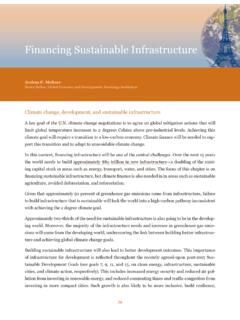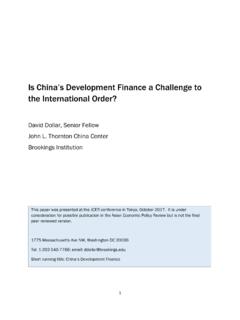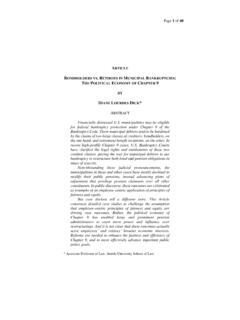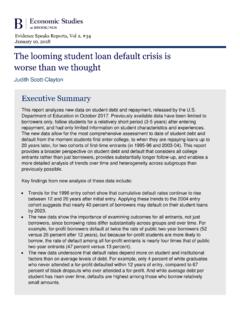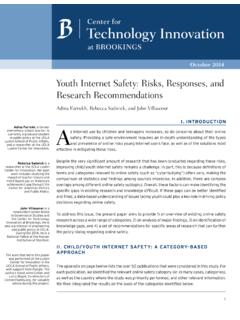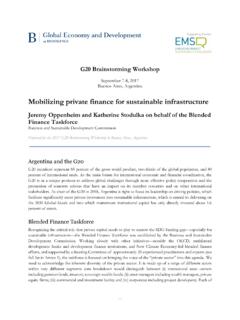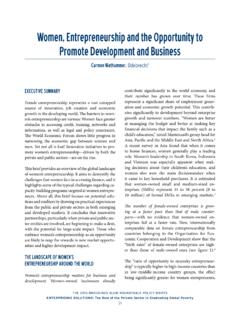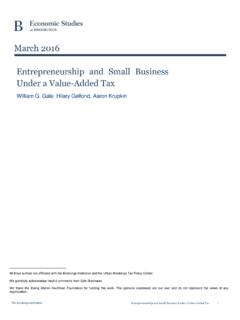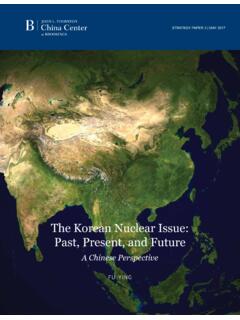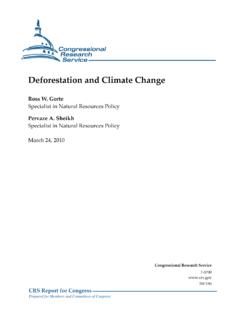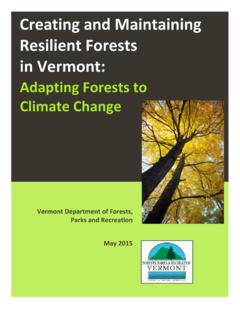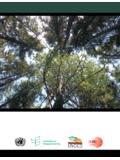Transcription of Climate Change and Forestry: An Introduction - Brookings
1 Climate Change is one of the most significant global challenges of our time,and addressing it requires the urgent formulation of comprehensive andeffective policy responses. A changing Climate affects nearly every sector of theworld s economy and is intricately intertwined with other major environmentalthreats such as population growth, desertification and land degradation, air andwater pollution, loss of biodiversity, and deforestation. To date, most of the inter-national attention directed toward combating Climate Change has been strikinglyinsufficient and focused primarily on the industrial and energy sectors. The agri-culture, forestry, and other land use sector AFOLU in current Climate policyjargon has so far been treated as an unwelcome distraction from tackling indus-trial and energy-related emissions, rather than being seen as an integral part ofthe Climate Change problem for which we must develop comprehensive resulting bias has led international Climate negotiators to disregard themajor role forests and agricultural systems play in Climate Change .
2 In the contextof the Kyoto Protocol, widespread controversies and a lack of knowledge madenegotiators agree to too little too result is not withstanding the recog-nition in 1997 that, with the adoption of the Kyoto Protocol, any attempt to sta-bilize atmospheric greenhouse gas (GHG) concentrations will have to bringland-use-related emissions and removals into the equation. According to a 2006study led by former World Bank chief economist Nicholas Stern, the costs ofreducing the effects of Climate Change can be significantly lowered if reducedClimate Change and Forestry: An Introductioncharlotte streck, robert o sullivan, toby janson-smith, and richard tarasofsky1301-8192-9 CH 1 5/27/08 5:00 PM Page 3deforestation and reforestation options are used effectively: Curbing deforesta-tion is a highly cost-effective way of reducing greenhouse gas emissions and hasthe potential to offer significant reductions fairly quickly.
3 It also helps preservebiodiversity and protect soil and water quality. Encouraging new forests andenhancing the potential of soils to store carbon offer further opportunities toreverse emissions from land use Change . 3 The idea for this book was triggered by the conviction that an effective post-Kyoto agreement must include a comprehensive system that allows for the ac-counting of land-use-related emissions and removals and establishes incentives toreduce emissions from deforestation. With a view to the forthcoming debate, wethought the time was ripe to compile existing knowledge, expertise, and experi-ence and make it available in one volume. At the same time we sought to producea practical reference manual outlining the history of AFOLU in international cli-mate Change negotiations, identifying key lessons learned from implementing thevarious policy frameworks and from actual forestry project experience to date, anddrawing on all this to propose solutions for how best to move forward.
4 This bookhas benefited from contributions and input by the leading forestry and climatechange experts in government, international organizations, academe, civil society,and the private this chapter we provide a short overview of the role of forestry and agricul-ture in current Climate policies a recurring theme throughout the book. Like theother contributors, we focus our review on potential approaches to incorporatingcarbon sequestration and emission avoidance into emerging Climate policy frame-works, rather than addressing the scientific debate that has surrounded the topicof Climate Change and forestry, which has already been written about at and Climate Change Forests are the world s most important terrestrial storehouses of carbon, and theyplay an important role in controlling its Climate .
5 The world s remaining forestecosystems store an estimated 638 gigatonnes (Gt) of carbon, 283 Gt of whichare in the forest biomass is a significant amount of carbon approx-imately 50 percent more than all the carbon in the atmosphere. forest ecosystemsare sensitive to climatic Change . Over long periods of time plants have adapted tolocal climatic, atmospheric, and soil conditions, and this, combined with tem-perature and rainfall patterns, is what characterizes an ecosystem. A Change inthese variables can dramatically affect species viability. Stress caused by a Change inthe conditions of an ecosystem may also increase its vulnerability to pests andfires. Thus, massive areas of forests could be lost from these Climate -inducedthreats, which in turn could further accelerate Climate Change in a vicious posi-tive feedback streck, r.
6 O sullivan, t. janson-smith, and r. tarasofsky01-8192-9 CH 1 5/27/08 5:00 PM Page 4On the other hand, land-based activities represent one of the most significantuntapped opportunities for mitigating Climate Change : Simply leaving mature forests intact will lock up significant amounts of car-bon that might otherwise be released into the atmosphere. Land-use changes, pre-dominately deforestation, currently contribute about one-fifth of global carbonemissions (see chapter 15). Deforestation is the greatest source of GHG emissionsin many developing countries, including Brazil and Indonesia, the world s biggestGHG emitters after the United States and China. Reducing emissions fromdeforestation may be one of the most cost-effective tools for reducing GHG emis-sions globally and could give people the time needed to mobilize the resourcesand develop the technology for decarbonizing the world s energy and industrialproduction.
7 Sustainably managed forests can produce wood and other biomass that is arenewable, carbon-neutral alternative to fossil fuels and other construction mate-rials. In this way sustainable forest management can help to reduce energy-relatedemissions (chapter 7). forest ecosystems contain the majority (approximately 60 percent) of thecarbon stored in terrestrial ecosystems and have the potential to absorb about10 percent of global carbon emissions projected for the first half of this centuryinto their biomass, soils, and associated products and, in principle, to store themin in Climate Negotiations Both the UN Framework Convention on Climate Change (UNFCCC) and theKyoto Protocol acknowledge the role that forests play in global Climate (chap-ter 3).
8 6 Whereas the UNFCCC tends to refer to the reduction of GHG emissionsand the increase of atmospheric GHG removals by sinks as parallel and equallyimportant elements in any Climate strategy, the Kyoto Protocol focuses on creat-ing a framework for reducing industry- and energy-related emissions. The defin-ing element of the Kyoto Protocol is a system of GHG emission targets withwhich all ratifying industrialized nations must comply. Reflecting the protocol sfocus on energy and industrial emissions, the targets of individual countries arecalculated without taking into account forestry- and land-use-related the negotiations that led to the adoption of the Kyoto Protocol, contro-versy arose over whether parties should be allowed to offset emissions produced inother sectors with removals generated by biological sequestration or whether theeffort to combat Climate Change should be concentrated on the reduction of emis-sions from the use of fossil fuels (chapter 4).
9 Those arguing against the accounting and use of forestry offsets were concernedthat carbon offsets might be negated in cases where human action or natural eventsclimate Change and forestry501-8192-9 CH 1 5/27/08 5:00 PM Page 5such as wildfires reversed the carbon benefits. If a tree is felled, stored carbon isreleased and the temporary Climate benefit reversed that is, the benefit is non-permanent. The existence of this permance risk distinguishes emission removalsgenerated by the forestry section from emission reductions generated by the indus-trial and energy sectors. The issue has, therefore, been a core concern about cred-its from activities that rely on sequestration of carbon in trees or negotiators decided in Kyoto that direct human-induced changesin GHG emissions and removals by sinks since 1990 could be used to meet a por-tion of the parties emission commitments.
10 Furthermore, articles 6 and 12, whichdefine the project-based mechanisms called Joint Implementation (JI) and theClean Development Mechanism (CDM), refer directly, in the case of JI, or at leastindirectly, in the case of the CDM, to carbon sinks. AFOLU under the CDM islimited, however, to afforestation and reforestation projects, which are grantedcredits that can be used only for a limited period of time to comply with Kyotocommitments (chapter 6). The regulatory limitations of forestry under the CDMhave subsequently severely hampered the development of this sector (chapter 8).Nevertheless, the experience with crediting carbon from afforestation andreforestation projects has helped to create knowledge and overcome the scientificuncertainties that, among other things, stood in the way of an early agreementon expanded consideration of the forestry sector (chapter 10).
